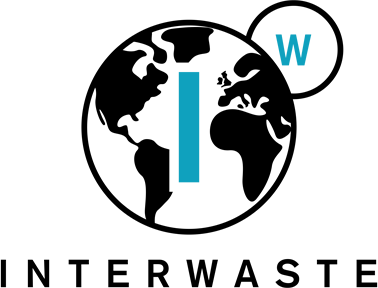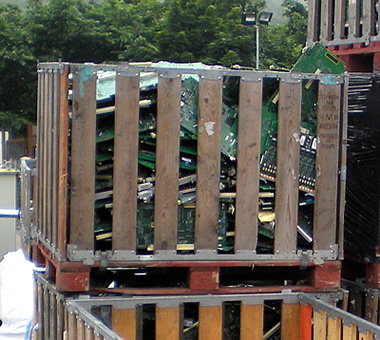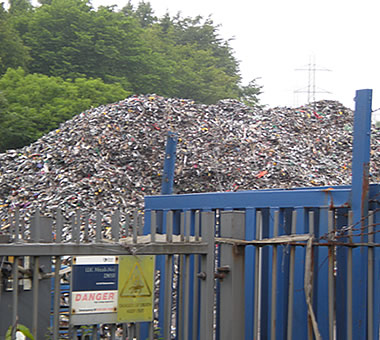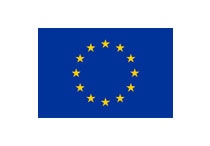 Synergising International Research Studies into the Environmental Fate and Behaviour of Toxic Organic Chemicals in the Waste Stream (INTERWASTE)
Synergising International Research Studies into the Environmental Fate and Behaviour of Toxic Organic Chemicals in the Waste Stream (INTERWASTE)
A Marie Skłodowska-Curie Research and Innovation Staff Exchange Project
Project duration: 1st January 2017- 31st December 2020
The overall vision of INTERWASTE is to develop scientific understanding of issues related to environmental contamination with toxic and/or hazardous organic chemicals (specifically flame retardants (FRs) and pharmaceutical and personal care products (PPCPs)) arising from their presence in the waste stream. Our central hypothesis is that the presence of such chemicals in the waste stream represents a substantial environmental hazard. INTERWASTE will test this hypothesis by evaluating the extent of environmental contamination attributable to emissions from selected components of the waste stream, and further will evaluate the efficacy of actions to minimise such environmental contamination. This will be achieved by a co-ordinated programme of collaboration between 27 leading research centres from Europe, Africa, Asia, Australasia, North and South America.
Co-ordinated by Professor Stuart Harrad at the University of Birmingham , the programme is centred around 87 research secondments totalling 224 researcher months between world-leading research groups both within and outside the EU; coupled with 4 annual research workshops to discuss the latest findings. All secondments and workshops will be conducted within a framework designed to maximise the training and career development benefits to participating staff by providing them with opportunities for knowledge and skills acquisition, with a particular (but not exclusive) focus on early career researchers.
The relevance of INTERWASTE
Flame Retardants in Waste
 INTERWASTE addresses the growing appreciation of the environmental hazard associated with the presence of flame retardant chemicals (FRs) in waste electrical and electronic equipment (WEEE) and soft furnishings (e.g. sofas and fabrics). As many such items contain FRs at percent levels, UNEP estimates that 20-50 million t WEEE is generated globally every year, illustrate the scale of the problem. Moreover, the UK alone generated ~1 million t waste soft furnishings in 2012.
INTERWASTE addresses the growing appreciation of the environmental hazard associated with the presence of flame retardant chemicals (FRs) in waste electrical and electronic equipment (WEEE) and soft furnishings (e.g. sofas and fabrics). As many such items contain FRs at percent levels, UNEP estimates that 20-50 million t WEEE is generated globally every year, illustrate the scale of the problem. Moreover, the UK alone generated ~1 million t waste soft furnishings in 2012.
The disposal and/or recycling of such materials offer multiple pathways via which FRs may be emitted to the environment. While best environmental practice is to limit releases of any chemical to the environment, it is particularly important to minimise emissions of brominated FRs, like polybrominated diphenyl ethers (PBDEs) and hexabromocyclodecane (HBCDD), that, while banned in new goods as a result of concerns about their toxicity, persistence, and capacity for bioaccumulation and long range atmospheric transport, will still remain in older goods now entering the waste stream. Other current use FRs of potential concern include phosphate FRs (PFRs), in particular chlorinated PFRs, such as: tris(2-chloroethyl) phosphate (TCEP), tris(2-chloroisopropyl) phosphate (TCIPP), and tris(1,3-dichloro-2-propyl)phosphate (TDCIPP).
Environmental contamination with pharmaceuticals and chemicals present in personal care products
 Another growing issue relates to environmental contamination arising from the use of pharmaceuticals and chemicals present in personal care products (PPCPs). The quantities of such PPCPs entering the environment (e.g. via the sewerage system either as the parent compounds or metabolites) are projected to increase substantially for the foreseeable future, given the increasing and ageing global population. Concerns about such environmental contamination are compounded by the inherent biological activity of pharmaceuticals in particular, which raise concerns about both human and wildlife exposure that may arise via the presence of PPCPs and their metabolites in the environment.
Another growing issue relates to environmental contamination arising from the use of pharmaceuticals and chemicals present in personal care products (PPCPs). The quantities of such PPCPs entering the environment (e.g. via the sewerage system either as the parent compounds or metabolites) are projected to increase substantially for the foreseeable future, given the increasing and ageing global population. Concerns about such environmental contamination are compounded by the inherent biological activity of pharmaceuticals in particular, which raise concerns about both human and wildlife exposure that may arise via the presence of PPCPs and their metabolites in the environment.
Moreover, while PPCPs are usually not environmentally persistent chemicals, their extensive and constant use and release to the environment, allows them to maintain a persistent environmental presence – thus PPCPs are often referred to as pseudo-persistent chemicals.
To achieve its overall vision, INTERWASTE has four strands of research activity, implemented by 7 linked work packages (WPs)

This project has received funding from the European Union’s Horizon 2020 research and innovation programme under the Marie Skłodowska-Curie grant agreement No 734522.
Any information expressed on these pages reflects only the views of the authors and the Research Executive Agency is not responsible for any use that may be made of the information these pages contain.